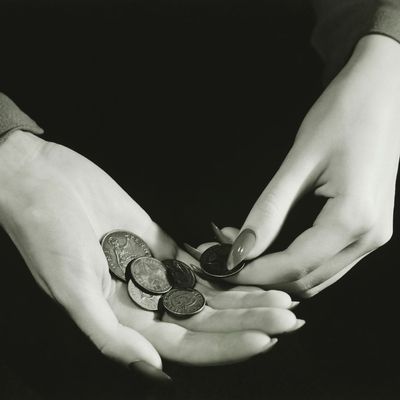
Sarah, 31, is a photo editor who made the leap to freelancing last year after the magazine where she was working folded. You could say she’s making it; she’s been able to use her contacts to build a client base, and she loves the work. Still, she feels like she’s barely scraping by. She’s never been good with money, and the constant up-and-down is starting to wear on her. She’s not sure how she can make this work in the long term; she could barely manage her taxes last year. What if she and her boyfriend want to pay for a wedding, or have a kid, or buy a place someday? How can she “trick” herself into saving money and creating more stability?
Freelancing is terrifying for the same reason it’s great: Every ball is in your court. You get to control how your work gets done and what to charge for it, which can be wildly appealing, especially after years of slinging emails under fluorescent lighting at your uninspiring day job. But as any freelancer will tell you, volatility is an occupational hazard — especially when it comes to money. There’s nothing liberating about chasing invoices and wondering when your next paycheck will come (or if it will come at all).
As a full-time editor, I’ve often indulged in fantasies about the freelance life, but I could never quite bring the financial picture into focus. I’ve done mental gymnastics (I’d save money on clothes, because I’d work in my pajamas!) and investigated health-insurance possibilities (with discouraging results: In New York, I couldn’t find anything under $400 per month). I’ve even written an entire column about how to transition to freelancing without going broke. But making the switch to freelancing is one thing; having a successful freelance career is another. How can you support yourself for the long haul when your income is bouncing all over the place? Even financially savvy people would struggle, and you — like many creative people — don’t count yourself among them.
The trick, according to Amy Northard, who bills herself as “the accountant for creatives,” is to treat yourself like a business — with an employee of one (you). “That means getting a separate bank account and having all your income and work-related expenses go through it,” she says. “Then, use the money in that account to pay yourself.” Ideally, you can mimic paychecks at regular intervals, just like a normal job, and cushion yourself from the feast-or-famine mind-set. Automate these transfers if possible; the fewer financial decisions you have to make, the lower your chances of making bad ones (like deciding to give your solo “employee” an impromptu raise for those plane tickets she wants to buy).
If you really struggle with self-discipline, you could even consider hiding your money from yourself, literally. Northard suggests setting up automatic transfers to an account at an entirely separate bank — one that you can’t withdraw from without considerable effort. (You can find bank accounts with no fees or minimums here.) My friend Amelia Edelman, a former freelance writer, used to freeze her credit card, Shopaholic style, when she was having a lean month. “I knew I couldn’t trust myself to not use it, and this was the only thing that worked,” she says. “Then, once the money started coming in again, I’d thaw it out.”
Edelman also recommends having at least one consistent gig that you can rely on. It doesn’t have to be fancy — for her, it was a part-time writing job for a medical-services organization. “In a pinch, I knew that I could cover my bare minimum living expenses with that income,” she says. While I’m sure there are exceptions, every successful freelancer I know has a setup like this: At least one steady “client,” ranging from the unglamorous (say, writing copy for a hardware website) to the dream (a magazine column), on top of which they can sprinkle extra assignments as they please. “It gave me peace of mind, and structure,” says Edelman.
Speaking of which: Hiring an accountant isn’t a requirement, but you should strongly consider it. “The one year I did my own taxes, I had eleven W-9 forms, and I’m pretty sure I lost a bunch of money,” says Edelman. A CPA will not only help prevent you from getting screwed by the IRS, but if you reach out before tax season (January or earlier), he or she can get you set up with a bookkeeping system and assist you with long-term money-planning. Helena Swyter, the founder of Sweeter CPA, which specializes in accounting services for creatives, says that it’s most important to find someone who makes you comfortable; most accountants will do an initial consultation for free, so shop around. “My advice is to find someone you like, and then ask a lot of questions,” she says.
While it’s hard to know whether using an accountant will save you cash (or at least pay for itself) until you try it, it will definitely prevent a headache. “Outsourcing taxes is a matter of spending more time on what you care about,” she says. “Sure, you could prepare your return, but it would take you 20 hours, and it would take me two. So you could pay me and spend that time doing what you actually want to be doing. And as part of putting a tax return together, I’m helping you restructure your books to make things flow smoothly.”
Of course, nothing will flow if there’s no money coming in, which brings us to the most essential part of freelancing: getting good at getting paid. Naming the price of your work is a worthy skill for any career, but if you’re self-employed, it’s paramount that you master it. “As with anything, research starts online,” says Alexandra Dickinson, the CEO and founder of Ask for It, an all-purpose training service for workplace negotiation. “Everyone wants to just look at the market rate for the job on Glassdoor and be done with it, but I recommend looking at a handful of sites. The other big ones are Payscale and Salary. I also love Comparably.”
But you aren’t done there — particularly since many freelancing gigs are highly specific and can’t really be addressed on salary websites. “You need to take it one step further, and this sometimes makes people uncomfortable, but it’s important: You need to talk to people in your industry about how much money they’re making,” says Dickinson. “Specifically, talk to people who do jobs that are similar to yours. It could also include someone who hires people like you, and would know how much you could ask for. You say, ‘I’m doing research because I’m preparing to ask my clients to increase my rate, and I think you have some information that would help me. Would you be willing to share your ballpark rates with me?’ People are usually willing to respond to that request.” If it still feels too forward, Dickinson recommends flipping the question: “You could say, ‘I’m thinking of asking for X rate. Does that sound reasonable to you?’”
Particularly for women, Dickinson says you should talk to no fewer than six people — three men and three women. “Everyone knows that the gender gap exists, but a lot of them don’t think it’s happening to them until they do this,” she explains. “It’s crucial to find men to ask about this, because chances are they’re making more. Literally no one has ever come back to me and said, ‘They’re all the same!’” Not only will this research arm you with extra confidence when you’re raising your rates, Dickinson says, but it’ll also light a fire under your butt: “You’ll be like, ‘This guy with the same background as me is making how much more? What?! I definitely deserve that.’”





